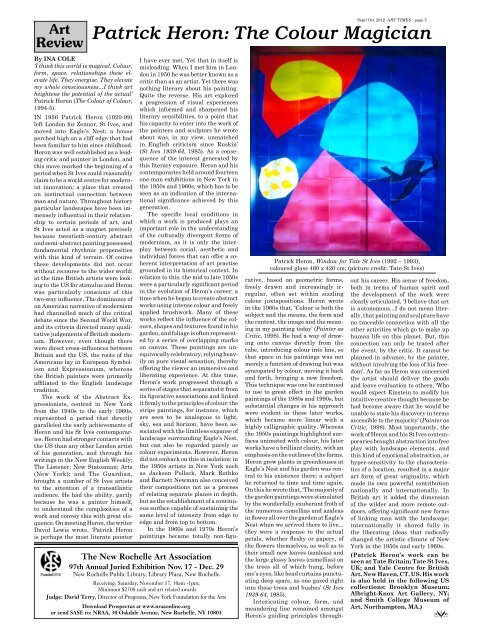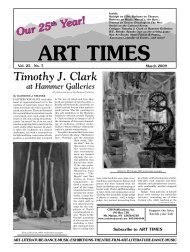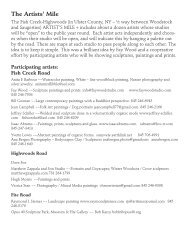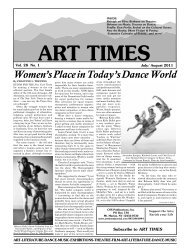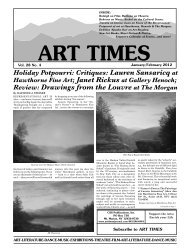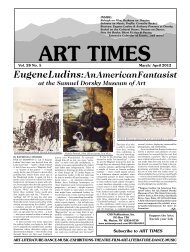September/ October 2012 - Art Times
September/ October 2012 - Art Times
September/ October 2012 - Art Times
Create successful ePaper yourself
Turn your PDF publications into a flip-book with our unique Google optimized e-Paper software.
<strong>Art</strong><br />
Review<br />
Sept/ Oct <strong>2012</strong> ART TIMES page 5<br />
Patrick Heron: The Colour Magician<br />
By Ina Cole<br />
‘I think this world is magical. Colour,<br />
form, space, relationships these elevate<br />
life. They energise. They elevate<br />
my whole consciousness...I think art<br />
heightens the potential of the actual’<br />
Patrick Heron (The Colour of Colour,<br />
1994-5).<br />
In 1956 Patrick Heron (1920-99)<br />
left London for Zennor, St Ives, and<br />
moved into Eagle’s Nest; a house<br />
perched high on a cliff edge that had<br />
been familiar to him since childhood.<br />
Heron was well established as a leading<br />
critic and painter in London, and<br />
this move marked the beginning of a<br />
period when St Ives could reasonably<br />
claim to be a world centre for modernist<br />
innovation; a place that created<br />
an instinctual connection between<br />
man and nature. Throughout history<br />
particular landscapes have been immensely<br />
influential in their relationship<br />
to certain periods of art, and<br />
St Ives acted as a magnet precisely<br />
because twentieth-century abstract<br />
and semi-abstract painting possessed<br />
fundamental rhythmic propensities<br />
with this kind of terrain. Of course<br />
these developments did not occur<br />
without recourse to the wider world:<br />
at the time British artists were looking<br />
to the US for stimulus and Heron<br />
was particularly conscious of this<br />
two-way influence. The dominance of<br />
an American narrative of modernism<br />
had channelled much of the critical<br />
debate since the Second World War,<br />
and its criteria directed many qualitative<br />
judgements of British modernism.<br />
However, even though there<br />
were direct cross-influences between<br />
Britain and the US, the roots of the<br />
Americans lay in European Symbolism<br />
and Expressionism, whereas<br />
the British painters were primarily<br />
affiliated to the English landscape<br />
tradition.<br />
The work of the Abstract Expressionists,<br />
centred in New York<br />
from the 1940s to the early 1960s,<br />
represented a period that directly<br />
paralleled the early achievements of<br />
Heron and his St Ives contemporaries.<br />
Heron had stronger contacts with<br />
the US than any other London artist<br />
of his generation, and through his<br />
writings in the New English Weekly;<br />
The Listener; New Statesman; <strong>Art</strong>s<br />
(New York); and The Guardian,<br />
brought a number of St Ives artists<br />
to the attention of a transatlantic<br />
audience. He had the ability, partly<br />
because he was a painter himself,<br />
to understand the complexities of a<br />
work and convey this with great eloquence.<br />
On meeting Heron, the writer<br />
David Lewis wrote, ‘Patrick Heron<br />
is perhaps the most literate painter<br />
The New Rochelle <strong>Art</strong> Association<br />
97th Annual Juried Exhibition Nov. 17 - Dec. 29<br />
New Rochelle Public Library, Library Plaza, New Rochelle<br />
Receiving: Saturday, November 17, 10am -1pm;<br />
Minimum $2500 cash and art related awards<br />
Judge: David Terry, Director of Programs, New York Foundation for the <strong>Art</strong>s<br />
Download Prospectus at www.nraaonline.org<br />
or send SASE to: NRAA, 30 Oakdale Avenue, New Rochelle, NY 10801<br />
Patrick Heron, Window for Tate St Ives (1992 – 1993);<br />
coloured glass 460 x 420 cm; (picture credit: Tate St Ives)<br />
I have ever met. Yet that in itself is<br />
misleading. When I met him in London<br />
in 1950 he was better known as a<br />
critic than as an artist. Yet there was<br />
nothing literary about his painting.<br />
Quite the reverse. His art explored<br />
a progression of visual experiences<br />
which informed and sharpened his<br />
literary sensibilities, to a point that<br />
his capacity to enter into the work of<br />
the painters and sculptors he wrote<br />
about was, in my view, unmatched<br />
in English criticism since Ruskin’<br />
(St Ives 1939-64, 1985). As a consequence<br />
of the interest generated by<br />
this literary exposure, Heron and his<br />
contemporaries held around fourteen<br />
one-man exhibitions in New York in<br />
the 1950s and 1960s, which has to be<br />
seen as an indication of the international<br />
significance achieved by this<br />
generation.<br />
The specific local conditions in<br />
which a work is produced plays an<br />
important role in the understanding<br />
of the culturally divergent forms of<br />
modernism, as it is only the interplay<br />
between social, aesthetic and<br />
individual forces that can offer a coherent<br />
interpretation of art practise<br />
grounded in its historical context. In<br />
relation to this, the mid to late 1950s<br />
were a particularly significant period<br />
in the evolution of Heron’s career; a<br />
time when he began to create abstract<br />
works using intense colour and freely<br />
applied brushwork. Many of these<br />
works reflect the influence of the colours,<br />
shapes and textures found in his<br />
garden, and foliage is often represented<br />
by a series of overlapping marks<br />
on canvas. These paintings are unequivocally<br />
celebratory, relying heavily<br />
on pure visual sensation, thereby<br />
offering the viewer an immersive and<br />
liberating experience. At this time,<br />
Heron’s work progressed through a<br />
series of stages that separated it from<br />
its figurative associations and linked<br />
it firmly to the principles of colour: the<br />
stripe paintings, for instance, which<br />
are seen to be analogous to light,<br />
sky, sea and horizon, have been associated<br />
with the limitless expanse of<br />
landscape surrounding Eagle’s Nest,<br />
but can also be regarded purely as<br />
colour experiments. However, Heron<br />
did not embark on this in isolation: in<br />
the 1950s artists in New York such<br />
as Jackson Pollock, Mark Rothko<br />
and Barnett Newman also conceived<br />
their compositions not as a process<br />
of relating separate planes in depth,<br />
but as the establishment of a continuous<br />
surface capable of sustaining the<br />
same level of intensity from edge to<br />
edge and from top to bottom.<br />
In the 1960s and 1970s Heron’s<br />
paintings became totally non-figurative,<br />
based on geometric forms,<br />
freely drawn and increasingly irregular,<br />
often set within sizzling<br />
colour juxtapositions. Heron wrote<br />
in the 1960s that, ‘Colour is both the<br />
subject and the means, the form and<br />
the content, the image and the meaning<br />
in my painting today’ (Painter as<br />
Critic, 1998). He had a way of drawing<br />
onto canvas directly from the<br />
tube, introducing colour into line, so<br />
that space in his paintings was not<br />
merely a function of drawing but was<br />
syncopated by colour, moving it back<br />
and forth, bringing a new freedom.<br />
This technique was one he continued<br />
to use to great effect in the garden<br />
paintings of the 1980s and 1990s, but<br />
substantial changes in his approach<br />
were evident in these later works,<br />
which became more linear with a<br />
highly calligraphic quality. Whereas<br />
the 1950s paintings highlighted surfaces<br />
animated with colour, his later<br />
works have a brilliant clarity, with an<br />
emphasis on the outlines of the forms.<br />
Heron grew plants in greenhouses at<br />
Eagle’s Nest and his garden was central<br />
to his existence there; a subject<br />
he returned to time and time again.<br />
On this he wrote that, ‘The majority of<br />
the garden paintings were stimulated<br />
by the wonderfully exuberant froth of<br />
the numerous camellias and azaleas<br />
in flower all over the garden at Eagle’s<br />
Nest when we arrived there to live...<br />
they were a response to the actual<br />
petals, whether fleshy or papery, of<br />
the flowers themselves, as well as to<br />
their small new leaves (azaleas) and<br />
the large glossy leaves (camellias) on<br />
the trees all of which hung, before<br />
one’s eyes, like bead curtains punctuating<br />
deep space, as one gazed right<br />
into these trees and bushes’ (St Ives<br />
1939-64, 1985).<br />
Intoxicating colour, form, and<br />
meandering line remained amongst<br />
Heron’s guiding principles through-<br />
out his career. His sense of freedom,<br />
both in terms of human spirit and<br />
the development of the work were<br />
clearly articulated, ‘I believe that art<br />
is autonomous...I do not mean literally,<br />
that painting and sculpture have<br />
no traceable connection with all the<br />
other activities which go to make up<br />
human life on this planet. But, this<br />
connection can only be traced after<br />
the event, by the critic. It cannot be<br />
planned in advance, by the painter,<br />
without involving the loss of his freedom’.<br />
As far as Heron was concerned<br />
the artist should deliver the goods<br />
and leave evaluation to others, ‘Who<br />
would expect Einstein to modify his<br />
intuitive creative thought because he<br />
had become aware that he would be<br />
unable to state his discovery in terms<br />
accessible to the majority’ (Painter as<br />
Critic, 1998). Most importantly, the<br />
work of Heron and his St Ives contemporaries<br />
brought abstraction into free<br />
play with landscape elements, and<br />
this kind of emotional abstraction, or<br />
hyper-sensitivity to the characteristics<br />
of a location, resulted in a major<br />
art form of great originality, which<br />
made its own powerful contribution<br />
nationally and internationally. In<br />
British art it added the dimension<br />
of the wilder and more remote outdoors,<br />
offering significant new forms<br />
of linking man with the landscape;<br />
internationally it shared fully in<br />
the liberating ideas that radically<br />
changed the artistic climate of New<br />
York in the 1950s and early 1960s.<br />
(Patrick Heron’s work can be<br />
seen at Tate Britain; Tate St Ives,<br />
UK; and Yale Centre for British<br />
<strong>Art</strong>, New Haven, CT, US. His work<br />
is also held in the following US<br />
collections: Brooklyn Museum;<br />
Albright-Knox <strong>Art</strong> Gallery, NY;<br />
and Smith College Museum of<br />
<strong>Art</strong>, Northampton, MA.)<br />
ef


